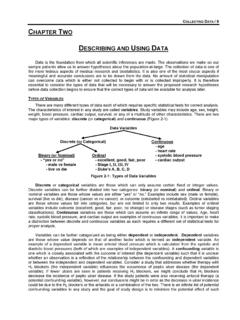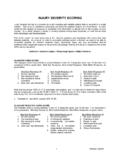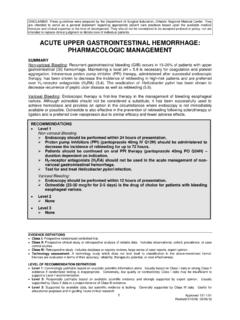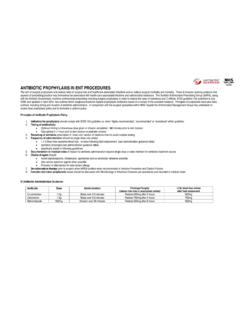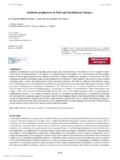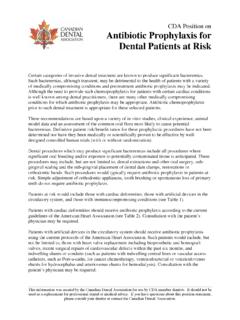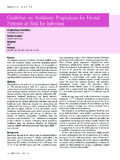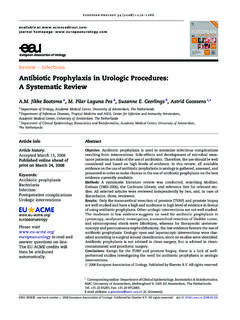Transcription of ANTIBIOTIC PROPHYLAXIS IN SURGERY
1 DISCLAIMER: These guidelines were prepared by the Department of Surgical Education, Orlando Regional Medical Center. They are intended to serve as a general statement regarding appropriate patient care practices based upon the available medical literature and clinical expertise at the time of development. They should not be considered to be accepted protocol or policy, nor are intended to replace clinical judgment or dictate care of individual patients. ANTIBIOTIC PROPHYLAXIS IN SURGERY . SUMMARY. Antimicrobial PROPHYLAXIS is used to reduce the incidence of postoperative wound infections. Patients undergoing procedures associated with high infection rates, those involving implantation of prosthetic material, and those in which the consequences of infection are serious should receive perioperative antibiotics.
2 Treatment, rather than PROPHYLAXIS , is indicated for procedures associated with obvious preexisting infection ( abscess, pus, or necrotic tissue). Cephalosporins (such as cefazolin) are appropriate first line agents for most surgical procedures, targeting the most likely organisms while avoiding broad-spectrum antimicrobial therapy that may lead to the development of antimicrobial resistance. Duration of PROPHYLAXIS should not exceed 24 hours. RECOMMENDATIONS. Level I. A single preoperative dose of ANTIBIOTIC is preferred as it is as effective as a full 5-day course of post-operative therapy assuming an uncomplicated procedure. Prophylactic antibiotics should be administered within 1 hour prior to incision.
3 Complicated-contaminated or dirty procedures should receive additional post-operative ANTIBIOTIC coverage. Level II. Prophylactic antibiotics should target the anticipated organisms. For the majority of procedures, PROPHYLAXIS should not exceed 24 hours. PROPHYLAXIS is unnecessary if the patient is already receiving antibiotics that cover likely pathogens. The timing of ANTIBIOTIC administration should be adjusted to maximize prophylactic efficacy. During prolonged procedures, ANTIBIOTIC PROPHYLAXIS should be re-administered every 4 hours (with the exception of vancomycin, aminoglycosides, and fluoroquinolones). Level III. Re-administration of prophylactic antibiotics is recommended for each 1500 mL of blood loss or hemodilution.
4 INTRODUCTION. Surgical site infections (SSI's) account for approximately 15% of nosocomial infections and are associated with prolonged hospital stays and increased costs. Infection develops when endogenous flora are translocated to a normally sterile site. Seeding of the operative site from a distant site of infection can also occur (especially in patients with a prosthesis or other implant). Factors influencing the development of SSI's include bacterial inoculum and virulence, host defenses, perioperative care, and intraoperative management. Unfortunately, an increasing number of resistant pathogens, such as methicillin-resistant EVIDENCE DEFINITIONS. Class I: Prospective randomized controlled trial.
5 Class II: Prospective clinical study or retrospective analysis of reliable data. Includes observational, cohort, prevalence, or case control studies. Class III: Retrospective study. Includes database or registry reviews, large series of case reports, expert opinion. Technology assessment: A technology study which does not lend itself to classification in the above-mentioned format. Devices are evaluated in terms of their accuracy, reliability, therapeutic potential, or cost effectiveness. LEVEL OF RECOMMENDATION DEFINITIONS. Level 1: Convincingly justifiable based on available scientific information alone. Usually based on Class I data or strong Class II. evidence if randomized testing is inappropriate.
6 Conversely, low quality or contradictory Class I data may be insufficient to support a Level I recommendation. Level 2: Reasonably justifiable based on available scientific evidence and strongly supported by expert opinion. Usually supported by Class II data or a preponderance of Class III evidence. Level 3: Supported by available data, but scientific evidence is lacking. Generally supported by Class III data. Useful for educational purposes and in guiding future clinical research. 1 Approved 10/17/06. Revised 03/13/12. Staphylococcus aureus (MRSA) and Candida spp., are commonly implicated in surgical wound infections. For patients who have demonstrated recent infection with MRSA or vancomycin-resistant Enterococcus.
7 (VRE), PROPHYLAXIS with clindamycin, vancomycin, linezolid (Zyvox ), or quinupristin/dalfopristin . (Synercid ) should be considered based on available culture susceptibilities (1-3,5). The goal of prophylactic antibiotics is to reduce the incidence of postoperative wound infection. It is important to recognize the difference between prophlyaxis and empiric therapy. PROPHYLAXIS is indicated for procedures associated with high infection rates, those involving implantation of prosthetic material, and those in which the consequences of infection are serious. The ANTIBIOTIC should cover the most likely contaminating organisms and be present in the tissues when the initial incision is made.
8 Therapeutic concentrations should be maintained throughout the procedure. Empiric therapy is the continued use of antibiotics after the operative procedure based upon the intraoperative findings. Empiric ANTIBIOTIC therapy is addressed in a separate guideline. Inappropriate PROPHYLAXIS is characterized by unnecessary use of broad-spectrum agents and continuation of therapy beyond the recommended time period. These practices increase the risk of adverse effects and promote emergence of resistant organisms. The traumatically injured patient represents a population in which antibiotics cannot be given before bacterial contamination occurs. An important principle of ANTIBIOTIC PROPHYLAXIS is violated, raising the issue of whether or not antimicrobial administration in these patients truly represents PROPHYLAXIS .
9 As a result, both short and long-term regimens have been advocated. Numerous studies have been conducted to identify the optimal duration of therapy in this population. The Joint Commission on Accreditation of Healthcare Organizations and the Centers for Medicaid and Medicare Services (CMS) mandate reporting of the following performance measures on a monthly basis. Compliance with reporting these performance measures is directly linked to CMS reimbursement. The performance measures currently mandated are as follows: 1. Prophylactic antibiotics must be administered to the patient within 1 hour prior to surgical incision. 2. Prophylactic antibiotics must be discontinued within 24 hours from the end of SURGERY .
10 The procedures included in the CMS standards included coronary artery bypass grafting (CABG), cardiac SURGERY , hip arthroplasty, knee arthroplasty, colon SURGERY , hysterectomy, and vascular SURGERY . Patients who have a documented infection at the time of SURGERY or within 48 hours post-operatively are excluded from the 24 hours rule. Additionally, post-cardiothoracic SURGERY patients are allowed up to 48 hours of post-operative ANTIBIOTIC therapy (5,6,8). LITERATURE REVIEW. Numerous studies have been performed investigating the utility of prophylactic antibiotics in SURGERY . A. wide variety of antibiotics, either singly or in combination, have been evaluated. With regards to surgical PROPHYLAXIS , the data from these studies support several recurring themes: A single preoperative dose of ANTIBIOTIC is preferred as it is as effective as a full 5-day course of post-operative therapy assuming an uncomplicated procedure (1,2,11,13).



